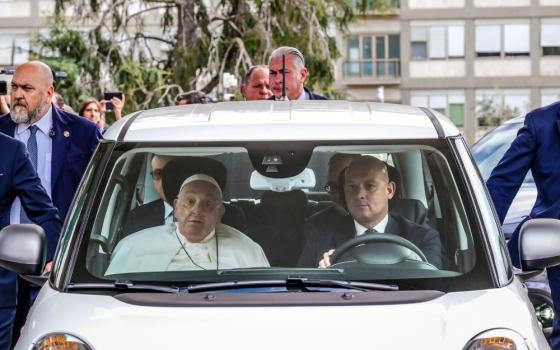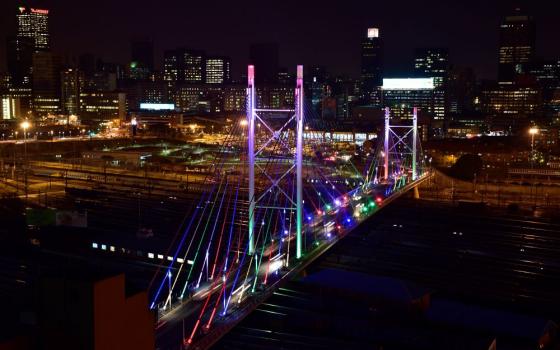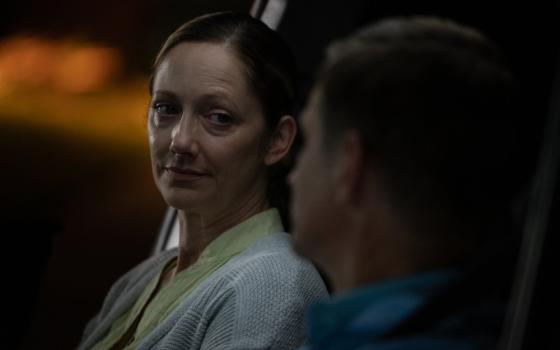Apache Catholics at a New Mexico parish told OSV News more questions than answers remain after two pieces of art belonging to the community were suddenly removed from their church, then returned to tribal offices a few days later after public outcry — with no clear explanation from diocesan personnel, the now-former pastor and other individuals apparently connected to the matter.
Parishioners with whom OSV News spoke also said the incident and its handling by the diocese underscore the need for greater pastoral efforts in effective ministry to the church's Indigenous Catholics, especially following the U.S. Conference of Catholic Bishops' overwhelming approval in June of a new pastoral framework for Indigenous Catholic ministry.
"Apache Christ" by Franciscan Friar Robert Lentz, an 8-foot icon depicting Jesus in the style of a Mescalero Apache holy man with the inscription in Apache "giver of life," and a painting of an Apache crown dancer by the late Apache artist Gervase Peso were taken June 26 from St. Joseph Apache Mission in Mescalero, New Mexico. Additionally several liturgical items reflecting Indigenous culture were missing.
The church, built by Franciscans and volunteers in 1920 to replace a smaller adobe church, is located on the lands of the Mescalero Apache Tribe. The mission is a parish within the Diocese of Las Cruces, New Mexico.
On July 3, the tribal government announced "with profound joy" on its Facebook page that "the paintings take(n) from St. Joseph Apache Mission have been returned to the tribe and the paintings will be returned to their locations in the church."
"Apache Christ," painted by Franciscan Friar Robert Lentz, has been returned to St. Joseph Mission, a church on tribal land in Mescalero, New Mexico, parishioners have confirmed to OSV News. (OSV News illustration/YouTube)
Harry Vasile — a Mescalero Apache tribal affiliate, as well as a St. Joseph volunteer and former parish staffer — confirmed to OSV News that he had brought the icon and painting in his own vehicle back to the mission that same day, having been alerted by a tribal official of the artwork's return. The icon and painting were reinstalled in their previous locations in the church.
Vasile and three other parishioners also told OSV News that Las Cruces Bishop Peter Baldacchino met for almost four hours with them and about a dozen parishioners July 9 at the parish center regarding the artwork's removal and return, as well as concerns about the cultural competence of diocesan ministry to the Apache community.
OSV News has called and emailed a number of Diocese of Las Cruces officials multiple times for comment, but has not received any response as yet.
A few days after the July 9 meeting, Vasile and fellow parishioner Pam Cordova, who serves on the parish finance council, both told OSV News that Father Martin Cordero, a diocesan priest, had been appointed pastor of St. Joseph Apache Mission, replacing Father Peter Chudy Sixtus Simeon-Aguinam. Cordero confirmed the appointment to OSV News by email July 12.
OSV News has been unable to verify with the Diocese of Las Cruces the location and assignment status of Simeon-Aguinam. However, on July 5, parish volunteer youth minister and catechist AnneMarie Brillante posted on a Google webpage she had created for the parish that the missing liturgical items had been "left in the priest's house along with his (Father Simeon-Aguinam's) keys." OSV News attempted to reach Father Simeon-Aguinam for comment several times, but never received a response.
Advertisement
Security footage provided to OSV News by Brillante shows that Simeon-Aguinam was directly involved in the removal of at least some of the artwork. The clips show a group of six adults, including Simeon-Aguinam, entering the church in mid-afternoon June 26 and taking out the Peso artwork from an area near the main entrance to the church. Due to the camera's location in the church, the icon's removal was not filmed; however, staff and volunteers discovered the next day that the painting and the icon, as well as Indigenous pottery vessels and a basket used for Mass, were missing.
In a June 27 phone call, Brillante had been told by Deacon John Eric Munson, the diocese's chief operating officer and head of human resources, that the artwork had been "not stolen, just removed," by the pastor, "the Knights of Columbus" and the diocesan property risk manager. Asked where the artwork was, Munson replied, "It's not germane."
Brillante posted to the Google webpage an audio recording of the call, along with the security footage, photos, and copies of multiple emails to the diocese regarding her concerns over Simeon-Aguinam's behavior, describing mental health concerns including erratic mood swings and seeming paranoia.
Anthony D. Salazar, state deputy of the New Mexico State Council of the Knights of Columbus, told OSV News by phone July 1 that regarding any Knights of Columbus who may have been involved in the icon's removal, "these gentlemen were acting on their own behalf" and "not ... in the capacity of a Knight of Columbus."
The Knights of Columbus have an extensive institutional commitment supporting Indigenous Catholics that features a Native Solidarity Initiative, the "Enduring Faith" documentary and their assistance promoting the sainthood cause of Nicholas Black Elk, a Lakota holy man and Catholic catechist. The Knights' Supreme Secretary Patrick Mason is a member of the Osage Nation.
Brillante told OSV News the July 9 meeting with the bishop, while providing an opportunity to share her concerns, yielded no clarification on why the images had been removed in the first place, and by whose authority and initiative.
The bishop "gave people the chance to express their woundedness, but he didn't really offer anything more than just kind of, 'I'm sorry, mistakes happen,'" Brillante told OSV News. "There was no personal responsibility for it."
Cordova told OSV News that while she and other participants "went in there with a lot of hope ... we were never given any answers."
Previously, Annemarie Brillante's 23-year-old daughter Gabrielle — currently a student at Yale Divinity School who assists her mother in parish catechetical ministry — told OSV News that she had received no further explanation when she queried Simeon-Aguinam after he stated at a June 11 parish meeting the Apache Christ icon was problematic for not meeting a Catholic "rubric."
The "Apache Christ" icon has been featured in St. Joseph Mission Church since 1990, following its completion by Brother Lentz. The friar, who designed the "Saints of the Americas" altar reredos in the Sante Fe, New Mexico, Cathedral Basilica of St. Francis of Assisi, has generated controversy with some of his other work — for example, his painting of slain politician and gay rights activist Harvey Milk. However, none of the sources OSV News spoke with said they were aware of any complaints as to the artist behind "Apache Christ" or any conflicts with Catholic doctrine in the icon's depiction.
The paintings' sudden removal June 26 came in the wake of what parishioners alleged to OSV News was their (now former) pastor's open antagonism toward Apache expressions of their Catholic faith that involved removal of chalices done in their culture's Pueblo pottery style and offertory baskets. One parishioner, who asked to remain anonymous due to fear of retaliation, told OSV News that Simeon-Aguinam said in a homily during a weekday Mass in Lent, "God comes first. You cannot be both an Apache and a Catholic. You have to choose. You cannot be both. ... You have to leave those ways and that way of life behind ... you have to choose." The parishioner was present at the Mass among five other members.
However, the U.S. Catholic bishops' framework for Indigenous Catholic ministry called "Keeping Christ's Sacred Promise" — overwhelmingly approved June 14 at their spring general assembly in Louisville, Kentucky — explicitly states the premise "be Native or be Catholic" involves "a false choice" and calls for healing, mission, reconciliation, holiness and transformation in ministry to the nation's Indigenous Catholics.
"Some believe an irreconcilable chasm exists between traditional Indigenous culture and Catholicism," the bishops teach. "For Native Catholics who feel this tension, we assure you, as the Catholic bishops of the United States, that you do not have to be one or the other. You are both. Your cultural embodiment of the faith is a gift to the Church."



